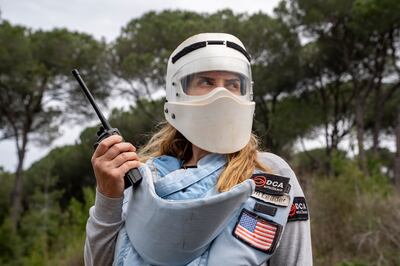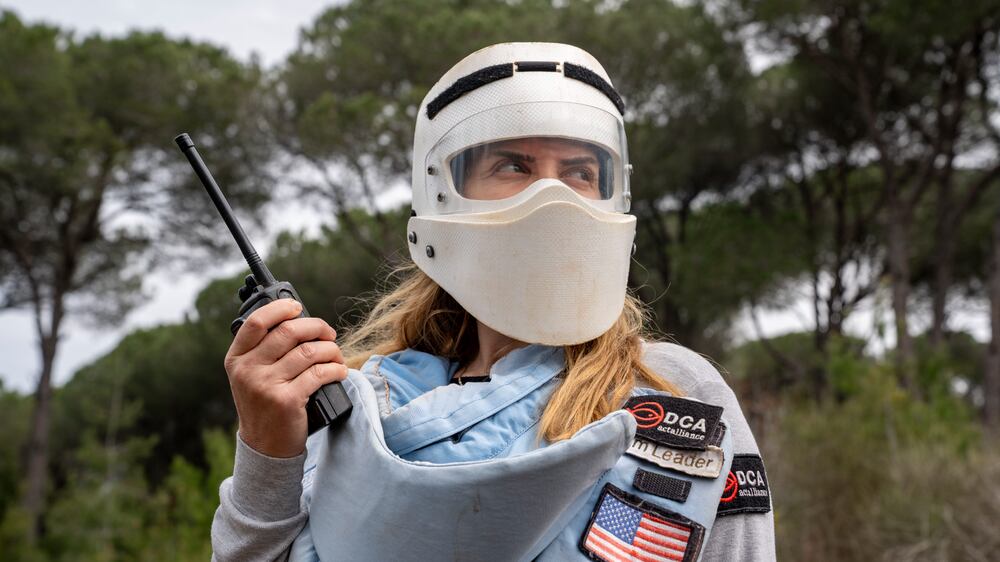Lina, dressed in a protective suit and a heavy mask, peers through her visor over her colleague Moussa's shoulder to carefully scan a patch of ground in front.
She is looking for objects that could potentially kill them both.
Satisfied with the inspection, Moussa uses a metal shaft to unearth the ground while Lina steps back to listen to a muffled communication on her walkie-talkie.
“We have to be meticulous about every centimetre,” says Lina, the mine clearance team leader for DanChurch Aid (DCA) Lebanon. “We can’t make any mistakes.”
Mine-clearing of this kind is slow, painstaking work.
Lina and her team are trying to find “undetectable” ordnance – explosives that cannot be picked up by metal detector – in an area about 24,000 square metres in Lebanon's Chouf region.
The field has been marked as dangerous and potentially contaminated.
Excavating manually through the shrubbery of this Lebanese hillside, each mine-clearer will cover about five to eight square metres a day, depending on conditions.
Lina and Moussa are among the hundreds of mine-clearers who are working in Lebanon to clear the 37,000 acres of land still contaminated by decades of domestic and regional conflict.
But the Hezbollah-Israel conflict in the south, combined with drastic cuts in funding, is casting doubt on the longevity of this vital work.
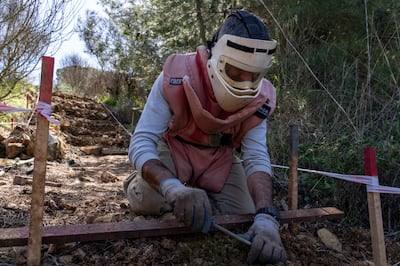
Deadly legacy of civil war
The area in the Chouf region where Lina and her team are working is about half an hour's drive from the capital, Beirut, and was contested between different militias during the Lebanese Civil War that lasted from 1975 to 1990.
During the conflict, hundreds of thousands of landmines were laid and millions of cluster bombs were dropped across the country.
Contaminated areas such as this are often identified on first-person accounts by militia men who fought in the areas, sometimes even by the fighters who originally laid the mines themselves.
Otherwise, unexploded ordnance is often discovered in tragic incidents.
Close to the area Lina and her team are clearing, a child was killed and another maimed when they stepped on an unexploded anti-personnel mine about 15 years ago.
Mine-clearers refer to incidents such as these as “accidents”.
Up until 2023, the deminers, along with a group of other international and national NGOs and the Lebanese Armed Forces, had been working to clear the “Blue Line”, the demarcation dividing Israel and Lebanon that the UN used in 2000 to determine Israel’s withdrawal after having occupied southern Lebanon since 1985.
As they withdrew, the Israelis laid hundreds of thousands of anti-personnel and anti-tank mines along the 120km border.
Furthermore, the conflict in 2006 between Hezbollah and Israel resulted in the latter dropping about four million cluster munitions into south Lebanon, up to 40 per cent of which did not explode.
What was left was more than one and a half million small explosives, no bigger than the size of a fist, lying dormant on the ground for years.
At the end of March, three peacekeepers were wounded by an exploding landmine during a foot patrol along the Blue Line.
Despite the efforts to clear mines, the number of “accidents” from unexploded mines has increased in recent years: From 10 victims - killed or wounded - in 2020, to 25 in 2021 and 22 in 2022.
The Lebanese Mine Action Centre (LMAC), the part of the Lebanese Army that leads and co-ordinates mine clearing, attributes these figures to socio-economic causes. As the country’s economic collapse has teetered from bad to worse, farmers have sought to maximise their land, cultivating closer to the Blue Line.
Meanwhile, people have ventured deeper into contaminated woodland for scrap metal or to collect firewood.
The LMAC has said the rate of accidents started to decline in 2023 because of educational and awareness programmes.
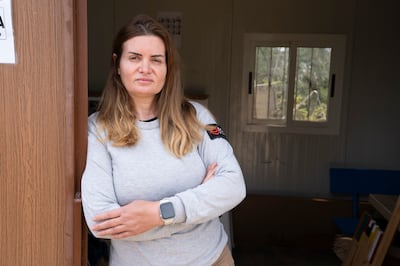
Funding under threat
The LMAC expected that Lebanon would be effectively decontaminated within this decade, having cleared all its cluster munitions by 2026 and landmines by 2028.
“That's if we have the capacity that we have planned for,” says DCA programme manager Mike Bonke.
“Unfortunately, it's clear that funding levels are about half where we would like them to be and so we should add additional years.”
The DCA’s funding has come mostly from the US, Japan and the Netherlands, but the war in Ukraine, along with other international crises, has drawn funding away from Lebanon.
Funding for mine-clearing in Lebanon has been significantly falling over the past few years – to $10.6 million in 2023, from $19.6 million in 2019.
“This substantial decline has had a notable impact on LMAC planning and its capacity to fulfil its completion,” Maj Chokor of the LMAC tells The National.
The LMAC initially predicted that it would take 20 mine clearing teams a decade to clear the Blue Line.
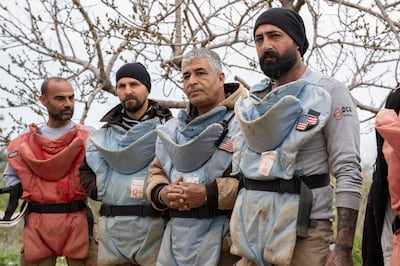
Gaza disrupts work
That prediction was before cross-border fighting erupted in southern Lebanon on October 8, when Hezbollah opened up a front after the Hamas attack on southern Israel on October 7.
Since then, towns and villages in southern Lebanon are subjected to almost daily aerial strikes and artillery fire from Israel, which has so far killed up to 380 people, mostly Hezbollah fighters.
Mine clearing along the Blue Line and in south Lebanon has since completely ceased.
The number of explosives that have been left from the fighting is also unknown, with teams unable to return to the conflict areas out of risk of being shelled.
“The problem is, for instance, if buildings have been destroyed, we don't know what's underneath. We don't know if there are still unexploded ordinances under the rubble,” says Mr Bonke.
At least five million square metres of land in south Lebanon have been scorched by Israel’s use of white phosphorus, which has long-term implications on the environment, economy and farming communities.
The fragments of the munition that hold the white phosphorus can also be dangerous and cause severe burns if uncovered even many months after being discharged.
White phosphorus is impossible to trace or discover using metal detector, and so decontamination would have to be done metre by metre, as Lina and Moussa demonstrated in the Chouf.
The LMAC say they are ready to examine the extent of the damage once a ceasefire is announced and enforced.
“Following the ceasefire, non-technical survey teams will be deployed in the south of Lebanon to define and identify the new contaminated areas in an evidence-based approach,” Maj Chokor confirms.
Questions as to whether funding – and how much of it – is made available by the international community for this work remain.
Meanwhile, as Hezbollah and Israel continue to fight, deminers continue to clear up the legacy of older conflicts.
“This is our country and, eventually, we have to rid it of landmines,” says Lina. “If we don't, who will?”
